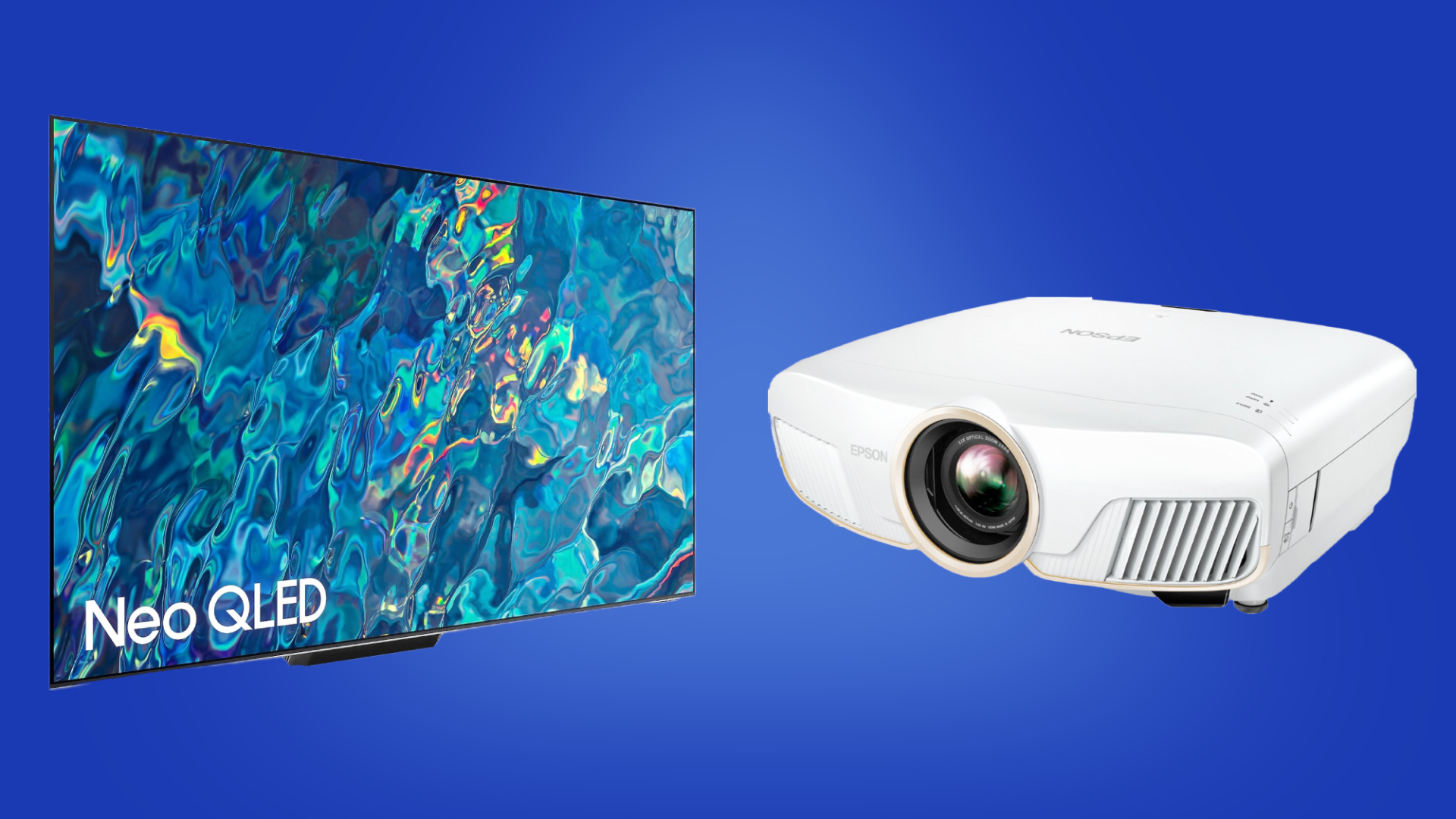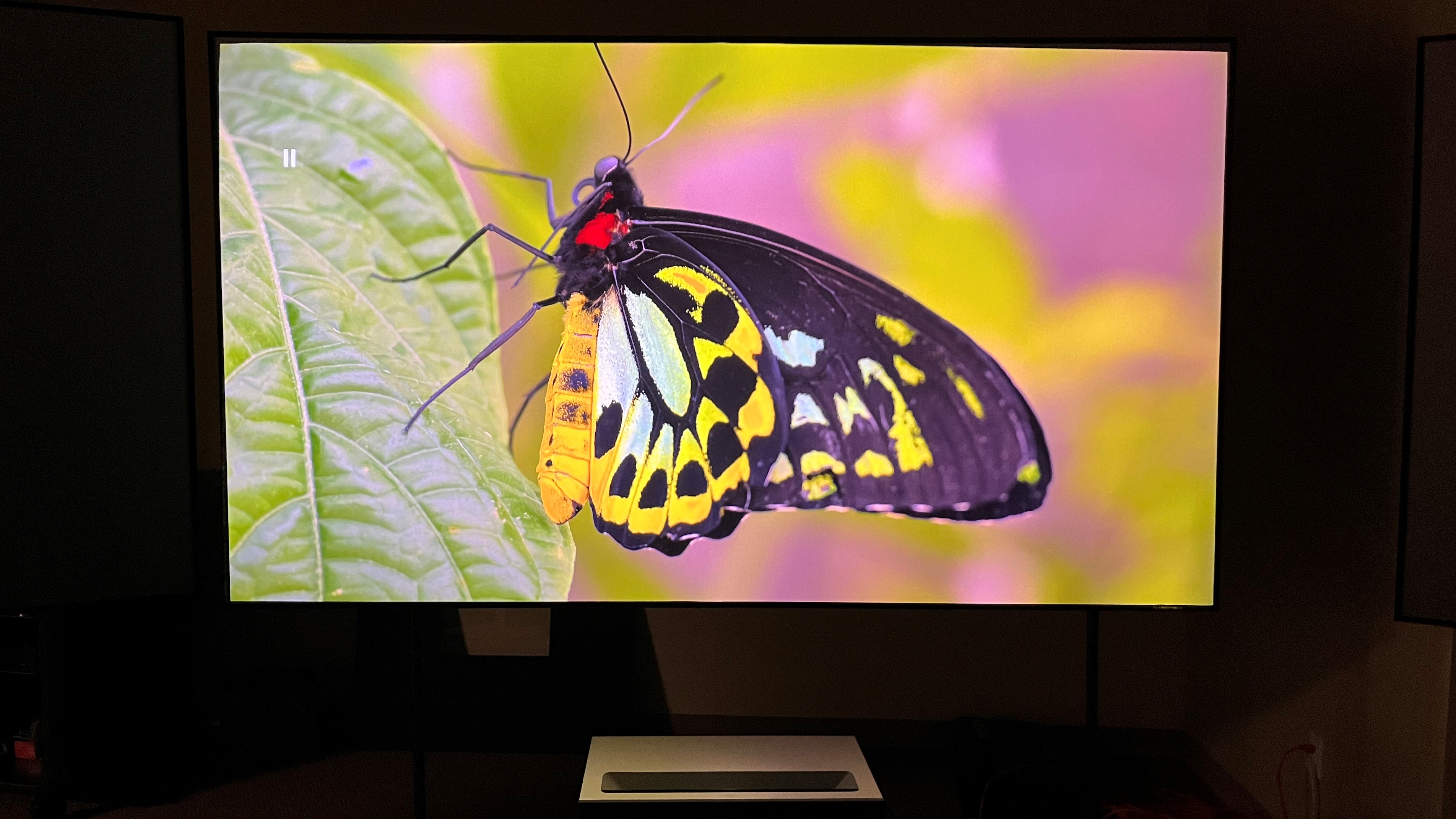Giant TVs vs projectors: which is best for movies, sports, and gaming?
The big bigscreen decision

Enormous TVs are in the news – yet again. At the recent IFA trade show in Berlin, LG had its just-released 97-inch OLED TV on display and it was an incredible sight to behold: bright, with crisp detail, and vivid colors. But even so, questions remain about how practical TVs with such a large screen size are, as well as how they compare with the projector and separate screen combinations more typically used to get a cinema-size image.
And then there is the question of value. Prices for 85-inch TVs start in the $2,000 / £2,000 / $AU3,000 range, a surprisingly low amount considering how much screen real estate you’re getting. But, same as TVs with smaller screens, there can be major performance differences between models, with sets priced several thousand dollars higher providing real benefits when it comes to watching movies and sports, or when playing games.
The best 4K projectors used for home theater, on the other hand, start in the $2-3,000 range and go up from there (way, way up in some instances for the best and the brightest models). And while you technically can just project images on a white wall, you’ll always get a better result when using a separate projection screen – at an added cost, of course.
So, after running the numbers, it might seem that giant TVs are the better value. But hold on – we’re not done making our comparison yet! There are several factors to consider about each technology when selecting one for your particular use case, and we’ll first run through each of them before making any conclusions.
Screen brightness and room lighting
Flat-panel OLED and QLED TVs deliver higher brightness than projectors – there’s really no comparison. Not only does this make them a better option for viewing sports and TV or playing games during daytime hours or in well-lit rooms, but it offers distinct advantages when watching 4K movies with high dynamic range (HDR).
In general, projectors have limited light output compared to TVs and will perform best when viewing in a dark environment, especially one where the lights are completely switched off. This makes them a perfect choice for watching movies, where you’ll want to dim the lights as much as possible to emulate the movie theater experience.
A more recent entry onto the projector scene is ultra short throw (UST) models such as the Hisense PX1 Pro and Samsung The Premiere. Depending on the model, these can be positioned as close as 4 inches away from a wall-mounted projection screen and project images as large as 150 inches. The screen material typically used for UST projectors is a special formulation used to filter out overhead light, so it’s possible to get good image quality with them even with room lights on.

Screen size
Projection screens used for home theater range up to around 150 inches diagonal (with a 16:9 aspect ratio), but a more common screen size is 100 to 120 inches. Compare your 97-inch OLED to that! Clearly, projectors have a strong advantage over TVs when it comes to image size, and when you consider that LG’s 97-inch TV costs €25,000 (around $27,500 / £21,000 / AU$37,000), there’s also a considerable value advantage.
Another related projector advantage: certain screen designs can be rolled up or down or retracted into a ceiling, letting them effectively disappear when not in use. Giant TVs, in contrast, take up lots of wall space, and unless you own one like the 85-inch version of Samsung’s The Frame ($4,300 / £4,300 / $AU6,400) which can cleverly display art and photos when not in use, you’ll be staring at a big dark gray rectangle during those times.
Picture resolution
Giant 85-inch and larger TVs really start to make sense when you’re talking about 8K video. Why? Because you’ll need a screen at least that size to appreciate the 4-times higher image resolution that 8K provides over 4K video. (When 8K video sources become more widely available, that is.)
While there are no true 8K projectors at present, there are 4K models like JVC’s DLA-NZ8 that use a rapid pixel-shifting process to achieve 8K resolution, and also support 8K video input over an HDMI 2.1 connection. But that JVC projector costs $16,000, or around 3 times as much as the least expensive 85-inch 8K TV. The takeaway here is that TVs, at least for the time being, are the more cost effective way to get 8K if that feature is important to you.
120Hz display and other gaming features
TVs with both an 85-inch screen and HDMI 2.1 features like 4K/120Hz, Auto Low Latency Mode (ALLM), and Variable Refresh Rate (VRR) that are important to gamers are surprisingly affordable, starting out at around $1,900 / £1,900 / $AU2,830. You can also expect these to offer a Game picture mode providing the around-10ms or less input lag that’s considered optimal for gaming.
And while gaming with an 85-inch TV sounds like a truly immersive experience, just think of what it would be like on a 120-inch screen – something I’ve personally done at home.
There are projectors offering the same HDMI 2.1 features mentioned above, including the JVC model mentioned above. But the input lag on projectors tends to be multiples higher than TVs, even when in Game mode. Depending on the level of intensity with which you play, that may not be a deal-breaker, but it still makes TVs the overall better option for gaming.
So which is best, giant TVs or projectors?
It depends on the use-case. It’s safe to say that giant TVs are a better option for viewing sports, which is generally done in daylight conditions, or with room lighting turned up. They also have an edge when it comes to gaming, due to their lower input lag compared with projectors and the more general availability of gamer-friendly HDMI 2.1 features on flat-panel OLED and QLED TVs.
UST projectors offer a distinctly TV-like setup, however. And when you consider that, when used with the proper screen, they can beam a 120-inch image that looks good in a relatively bright room, they are a higher-value and higher impact proposition than a giant TV for sports, movies, and gaming.
Projectors are an ideal option for movie fans due to both their ability to project truly cinematic 100-inch and larger images and their relative value when compared to, well, that 97-inch LG OLED TV, which costs $27,500. If you love watching movies, you’re going to want to dim the lights anyway, so the dark room requirement for projectors to look their best will be a perfectly acceptable and not at all bothersome trade-off.
Get daily insight, inspiration and deals in your inbox
Sign up for breaking news, reviews, opinion, top tech deals, and more.

Al Griffin has been writing about and reviewing A/V tech since the days LaserDiscs roamed the earth, and was previously the editor of Sound & Vision magazine.
When not reviewing the latest and greatest gear or watching movies at home, he can usually be found out and about on a bike.